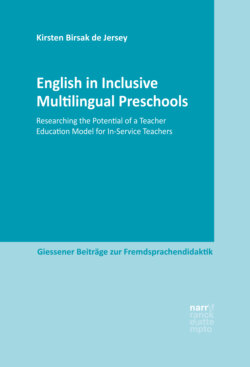Читать книгу English in Inclusive Multilingual Preschools - Kirsten Birsak de Jersey - Страница 27
4.3.2 Pedagogical content knowledge
ОглавлениеApart from a sound communicative English language competence, prospective English teachers need to be able to “make it [the target language] comprehensible to others” (Shulman, 1986, p. 9). This knowledge came to be termed pedagogical content knowledge in 1986 for the first time by Shulman. He defined it as “content knowledge that embodies the aspects of content most germane to its teachability … [that is] the ways of representing and formulating the subject that makes it comprehensible to others” (p. 9).
Through pedagogical content knowledge, teachers develop “the capability to transform content into accessible learning forms” (Burns & Richards, 2009, p. 3). It consists of both theory and practice and the inter-relationship of these two components and ultimately culminates in knowledge of how to teach and how to facilitate learning.
The question of what this knowledge base consists of has been explicitly addressed by research conducted in connection with finding out how teachers develop professionally. This required addressing the question of what qualifies as the knowledge base of second language teacher education to begin with (Freeman & Johnson, 1998, p. 407; Johnson, 2009, p. 21). Freeman and Johnson were among the first to react against the idea that until then prevailed the discussion that disciplinary knowledge1 and theories of second language acquisition (SLA) alone would prepare teachers adequately for language classrooms (Freeman & Johnson, 1998). Instead, they argued, the knowledge base of teacher education would need to be reconceptualised to include pedagogical content knowledge (Johnson, 2009, pp. 21-22). This knowledge base cannot be defined without a particular group of learners in mind. What can be defined, though, is the general approach and principles for teaching languages (→ chapter 5.8). The pedagogical content knowledge appropriate for a particular group of learners may only be developed by ‘translating’ these principles in the design of tasks that then have to be tested in practice and reflected on their appropriateness for this particular group of learners. This way teachers will gain an insight into problems that can occur, they will develop a perception of how to put theory to practice and will become aware of how they respond in and to their context (Schön, 1983, pp. 54-55; Johnson, 2009, p. 23). Reflecting practical experiences and drawing conclusions to improve the quality of learning for a particular group of learners form the basis for teachers’ decision making in classrooms. Therefore, what qualifies as appropriate content for a particular group of learners can only be defined through this process of reflection in context. This research therefore consequently sets up a teacher education model which supports participating teachers to develop the pedagogical content knowledge for their preschool groups.
The resulting research questions, the description of the preschool teacher education model and general approach that has been chosen to be able to understand and to reconstruct teachers’ development processes will be in the focus of the next chapter.
